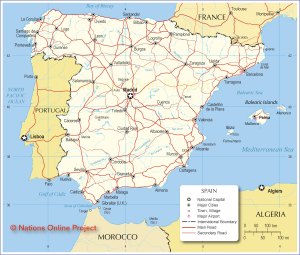For general information about the country profiles click here.
 Population: 46,761,264
Population: 46,761,264
HDI ranking: 23/187
HDI score: 0.885
Since the late 1970s, Spain has developed a highly decentralized government system in response to its strong and varied communities. Regions including Catalonia and the Basque Country, with distinct cultural and linguistic characteristics, were at the front of the push for decentralization. Yet decentralization has come to Autonomous Communities at different rates, leaving some more centrally-controlled than others (IMF, 2008).
Local governance at a glance
- The National Committee of Local Administration, a committee in the Ministry of Public Administration, serves as the body of cooperation between the state and local governments, reports on those state provisions or regulations that affect local entities, and is in charge of issues to do with Local Treasuries (GOB, 2013).
- While the Spanish Constitution includes provisions for local administration, it does not define “local” and does not outline a model for local governance. The Constitution does not define local autonomy or provide for financial guarantees to local bodies (UCLG, 2008).
- The local government is composed of (UNDESA, 2006; UCLG 2010):
- 17 Autonomous Communities and two autonomous cities;
- 50 Provinces, led by provincial councils indirectly elected by municipal councils; and
- 8,100 Municipalities, led by a directly elected council.
- In addition to municipalities and provinces, there are other local entities that include islands, territories smaller than municipalities, mancomunidades, comarcas, metropolitan areas, and other municipality groupings (GOB, 2006).
- Within Autonomous Communities, there are almost 4,000 territorial entities smaller than municipalities. Mancomunidades are larger than municipalities and are voluntary entities aimed to carry out joint projects and provide common services. There are more than 1,000 in the country. Autonomous Communities can create comarcas or metropolitan areas (GOB, 2006).
Civil society actors include
- The Funds for Cooperation and Solidarity is a coordination framework to promote decentralization cooperation within and outside the territorial areas of its members and foster networks between them.
- The Bank of Best Practices of local service is sponsored by Barcelona’s provincial government and the municipalities in the province to identify and disseminate innovative experiences of government and local administration
Capacity building institutions
- The Spanish Federation of Municipalitis and Provinces (FEMP) is an association of local entities to promote the autonomy, provide services and encourage ties and cooperation between local authorities and other organizations.
- The Catalan Association of Municipalities and Regions (ACM) is comprised of more than 95% of local authorities in Catalonia and works to defend the interests of municipalities in this region.
- There are Municipality Associations at the regional level in all of the Autonomous Communities (UCLG, 2008).
- WebMunicipal Councils is a meeting point for stakeholders including local mayors, councilors, officers, municipal workers, neighbors, and civic organizations to promote the exchange of information and practices for municipalities.
Fiscal control
- In 2009, the share of sub-national government spending was 49.2% of total government spending and 35% of total revenue (OECD, 2011).
- The Constitution mandates fiscal autonomy to Autonomous Communities to complete their duties and established the Autonomous Treasury Department. Local governments receive funding from both the Treasury of the State as well as the local departments (UCLG, 2008).
- The Spanish Constitution provides for fiscal autonomy for local government bodies, therefore, municipalities, provinces, and islands can make their own decisions regarding the use of resources and expenditures. It also provides for fiscal self-sufficiency to guarantee that all municipalities have adequate resources to fulfill their responsibilities (GOB, 2006).
- Local Treasuries have funding from income of self-owned assets, local taxes, shares of the State and Autonomous Communities’ taxes, public fares, subsidies, credit transactions, and fines (GOB, 2006).
Key initiatives for participatory local governance
- The 1978 Constitution mandated the principle of self-government of municipalities, provinces, and islands and guaranteed these bodies their right to participate in the affairs affecting their interests (GOB, 2006).
- The Constitution further allows for decentralization through the establishment of regional entities between the state and Autonomous Communities. All Autonomous Communities have lists of local duties (UCLG, 2008).
- The Basic Law on Local Government outlines provincial and municipal institutions and provides guidelines for sharing responsibilities (UNDESA, 2006).
- The Regulation of Local Government law, a foundation for local governance passed in 1985, has evolved through the Local Pact of 1999 and the Modernization of the Local Government in 2003 which reformed the law and introduced a new title to regulate the structure of local governments as well as municipalities with large populations (UCLG, 2008).
- The Autonomous Communities have agreed to present accounts quarterly instead of annually in an effort to increase budget transparency (OECD, 2012).
Challenges for participatory local governance
- Successive waves of fiscal decentralization have resulted in sub-national governments providing a significant amount of public services and greater fiscal autonomy. (EC, 2012). However during the recent global recession, as regional governments have spent more on infrastructure, education, and healthcare, tax revenues have been significantly reduced, contributing to significant regional government deficits (BBC, 2012).
Recent posts on this website about this country:
______________________
List of sources (in order of citation):
United Nations Development Program (UNDP), 2012. “International Human Development Indicators: Spain.”
International Monetary Fund (IMF), 2008. Ehtisham Ahmad, Giorgio Brosio, and Vito Tanzi. “IMF Working Paper, Local Service Provision in Selected OECD Countries: Do Centralized Operations Work Better?”
United Cities and Local Governments (UCLG), 2008. “Country Profile: Spain.”
United Nations Department of Economic and Social Affairs (UNDESA), 2006. “Kingdom of Spain Public Administration Country Profile.”
Ministerio De Administratciones Publicas, 2006. Gobierno de Espana. “Local Government in Spain.”
OECD, 2011. Claire Charbit. “Governance of Public in Decentralized Contexts, The Multi-Level Approach.”
OECD, 2012. “Regional Policy, Country Notes: Spain.”
EC, 2012. Pablo Hernandez de Cos and Javier J. Perez. “Sub-national public debt in Spain: political economy issues and the role of fiscal rules and decentralization.”
BBC, 2012. Laurence Knight. “Spain’s regional governments: How they got into trouble.”
